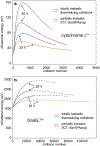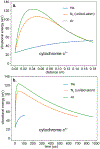Modeling collisional kinetic energy damping, heating, and cooling of ions in mass spectrometers: a tutorial perspective
- PMID: 39072228
- PMCID: PMC11271708
- DOI: 10.1016/j.ijms.2024.117290
Modeling collisional kinetic energy damping, heating, and cooling of ions in mass spectrometers: a tutorial perspective
Abstract
Many powerful methods in mass spectrometry rely on activation of ions by high-energy collisions with gas particles. For example, multiple Collision Induced Dissociation (CID) has been used for many years to determine structural information for ions ranging from small organics to large, native-like protein complexes. More recently, Collision Induced Unfolding (CIU) has proved to be a very powerful method for understanding high-order protein structure and detecting differences between similar proteins. Quantifying the thermochemistry underlying dissociation/unfolding in these experiments can be quite challenging without reliable models of ion heating and cooling. Established physical models of CID are valuable in predicting ion heating but do not explicitly include mechanisms for cooling, which may play a large part in CID/CIU in modern instruments. Ab initio and Molecular Dynamics methods are extremely computationally expensive for modeling CID/CIU of large analytes such as biomolecular ions. In this tutorial perspective, limiting behaviors of ion kinetic energy damping, heating, and cooling set by "extreme" cases are explored, and an Improved Impulsive Collision Theory and associated software ("Ion Simulations of the Physics of Activation", IonSPA) are introduced that can model all of these for partially inelastic collisions. Finally, examples of modeled collisional activation of native-like protein ions under realistic experimental conditions are discussed, with an outlook toward the use of IonSPA in accessing the thermochemical information hidden in CID breakdown curves and CIU fingerprints.
Keywords: collisional activation; ion thermochemistry; kinetics; simulations.
Conflict of interest statement
Research in the Prell Group is supported in part by a gift from Agilent Technologies.
Figures





References
-
- Wells JM, McLuckey SA, Collision-Induced Dissociation (CID) of Peptides and Proteins, in: Burlingame AL (Ed.) Methods Enzymol., Academic Press, Amsterdam, 2005, pp. 148–185. - PubMed
-
- Benesch JLP, Aquilina JA, Ruotolo BT, Sobott F, Robinson CV, Tandem Mass Spectrometry Reveals the Quaternary Organization of Macromolecular Assemblies, Chem. Biol, 13 (2006) 597–605. - PubMed
-
- Laskin J, Futrell J, On the efficiency of energy transfer in collisional activation of small peptides, J. Chem. Phys, 116 (2002) 4302–4310.
-
- Ruotolo BT, Hyung S-J, Robinson PM, Giles K, Bateman RH, Robinson CV, Ion Mobility–Mass Spectrometry Reveals Long-Lived, Unfolded Intermediates in the Dissociation of Protein Complexes, Angew. Chem. Int. Ed, 46 (2007) 8001–8004. - PubMed
Grants and funding
LinkOut - more resources
Full Text Sources

